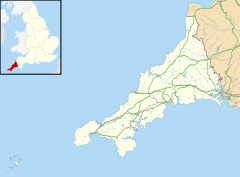Killifreth Mine was a mine near Chacewater in Cornwall, England, producing at various periods copper, tin and arsenic. The engine house over Hawke's Shaft is a Grade II listed building; it has the tallest surviving chimney in Cornwall.[1]
| Killifreth Mine | |
|---|---|
 The engine house at Hawke's Shaft, viewed from the north | |
| Location | Chacewater, Cornwall, England |
| Coordinates | 50°15′14.7″N 5°10′49.1″W / 50.254083°N 5.180306°W |
| OS grid reference | SW 733 442 |
Listed Building – Grade II | |
| Official name | Engine House Killifreth (Hawke's Shaft) at SW 733442 |
| Designated | 30 May 1967 |
| Reference no. | 1140971 |
Listed Building – Grade II | |
| Official name | Engine house at approx 50m west of Wheal Bush Farmhouse, Killifreth Mine |
| Designated | 3 May 1967 |
| Reference no. | 1140974 |
Listed Building – Grade II | |
| Official name | Engine house at approx 50m north west of Wheal Bush Farmhouse, Killifreth Mine |
| Designated | 30 May 1967 |
| Reference no. | 1140973 |
Listed Building – Grade II | |
| Official name | Engine house, part of Killifreth Mine, at SW 737442 |
| Designated | 3 February 1986 |
| Reference no. | 1328985 |
Listed Building – Grade II | |
| Official name | Engine house and boiler house and workshop ruins at Engine Shaft, part of Killifreth Mine, at SW 736442 |
| Designated | 3 February 1986 |
| Reference no. | 1140972 |
Listed Building – Grade II | |
| Official name | Mine chimney, part of Killifreth Mine, at SW 737443 |
| Designated | 3 February 1986 |
| Reference no. | 1140926 |
History
editThe mine produced copper from shallow workings from 1826 to 1860. Some time before 1856 the mine was joined to the Great County Adit, a branch coming from Wheal Busy. In 1864 it was bought by a new company, and tin was mined; it was deepened to 100 fathoms below the County Adit.[2][3]
The engine house over Hawke's Shaft (named after Edward Hawke Jnr, the purser in 1865) was built in 1892, and housed an 80-inch pumping engine. The bob (the beam of the beam engine) broke in 1897, and the mine was abandoned for a period.[1][4]
It was reopened in 1912, mining for arsenic. A new boiler house contained four boilers; these served an 85-inch pumping engine, a horizontal whim and an air compressor. The chimney was augmented to its present height. The price of arsenic was volatile, and the mine failed after a few years. Although there was an attempt to open the mine in 1927, no further mining took place.[2][3]
Description
editThe engine house at Hawke's Shaft is made of granite rubble and killas. It had three storeys; the walls are virtually intact. The thicker bob wall, on the south side, survives up to the wall plate, that supported the beam of the beam engine; above was originally timber framed with weather boarding. The chimney is the tallest surviving in Cornwall.[1]
Another engine house of Killifreth Mine is to the east at Engine Shaft, grid reference SW 736 442: there are ruins of a late 19th-century engine house, attached chimney and boiler house.[5]
See also
editReferences
edit- ^ a b c Historic England. "Engine house Killifreth (Hawke's Shaft) at SW 733442 (1140971)". National Heritage List for England. Retrieved 26 November 2020.
- ^ a b "Killifreth" Explore Cornwall. Retrieved 26 November 2020.
- ^ a b "Killifreth Mine, Cornwall" Cornwall Calling. Retrieved 26 November 2020.
- ^ D. B. Barton. Cornwall's Engine Houses. Tor Mark Press, 3rd edition 1999. Page 23.
- ^ Historic England. "Engine house and boiler house and workshop ruins at Engine Shaft, part of Killifreth Mine at SW 736442 (1140972)". National Heritage List for England. Retrieved 26 November 2020.
